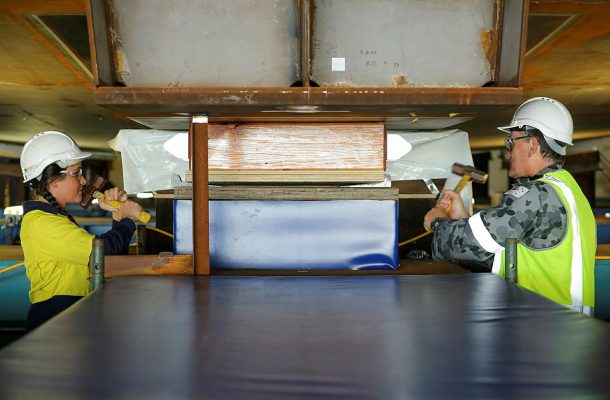Defence should lead from the front to solve the workforce shortage

In my last article, I illustrated the challenges that the defence sector faces in building the workforce required to support the government’s large planned investment in defence capability over the next decade. After recently attending a number of conferences and seminars, I can safely say that there’s now a good appreciation among senior defence sector leaders of the current, and increasing, shortage of workers across most defence industry disciplines.
There’s no silver-bullet solution to the worker shortage—and all will involve Defence making greater use of an external workforce—but some options will come easier and have bigger impacts than others. We can derive some easy wins from the experience of other sectors: how did the resources industry grow its workforce during the noughties resource boom?
It didn’t fully employ its pools of experienced mining, oil and gas workers and then simply wait for new graduates to slowly build up the numbers. Instead, the industry reframed its expectations of the experience its workers needed and hired people from adjacent industries. That’s what the defence sector must now do.
Defence’s Capability Acquisition and Sustainment Group (CASG) can lead this change from the front, and it has just the tool for the job, its major service providers (MSPs).
The MSP model was created in part to help CASG access the external workforce that it needed, and at better value for money than possible through the defence support services panel or its various predecessors.
One key goal was to move beyond the expensive short-term ‘body shop’ approach to outsourcing. By issuing the MSPs with large integrated work packages (IWPs) rather than requests for individual contractors, the model gave MSPs a sufficient ‘demand signal’ to encourage them to create enduring workforce capability.
An IWP gives full responsibility to an MSP to deliver the complete range of engineering, logistics, commercial and project management services to a Defence project or branch, thus delivering benefits of economies of scale and certainty.
I acknowledge that concerns have been raised about the marginalisation of small- and medium-sized enterprises (SMEs) under the MSP model. I am not seeking to address any real or perceived issues in these relationships, but want to focus attention solely on where the MSPs themselves can be leveraged to increase the overall workforce.
One of the true opportunities in the IWP approach is that it allows the MSPs to grow their workforces by hiring graduates and skilled workers with non-defence experience. I assume that one of the criteria for MSP selection was the providers depth of knowledge and capability in sectors other than defence, thus allowing it to blend this non-defence capability into the delivery of each IWP.
Based on my observations of the sector, this isn’t occurring nearly as widely as the MSPs (and Defence leadership) would like. There seem to be few examples of MSPs either using staff from their non-defence businesses or using their non-defence expertise to assess and recruit skilled workers from other industries. These instances are not at the scale needed to have a real impact, but any lessons learned bear examination so they may be applied on a larger scale.
A big obstacle seems to be that it’s common for CASG managers to be highly specific in their expectations of the type of personnel that an MSP (or its subcontracted SME) must provide. This leaves the MSP with no choice but to supply workers with the usual, niche defence skillsets and experience, tightening the talent pool dramatically, while increasing competition in the market more generally.
Sometimes these needs are driven by task urgency or security classification requirements, but at other times these conditions could be ameliorated with a more strategic approach to workforce planning.
An additional complication arises when CASG staff, many of whom aren’t used to assessing or managing workers with non-defence backgrounds, want to be heavily involved in the selection of MSP staff.
Aside from undermining the entire intent of the MSP concept—which is to release whole packages of work to the MSP rather than simply seek individual contractors to fill vacant positions in Defence project offices—in an ultra-competitive employment market, this risks injecting terminal delays into the recruitment process for new workers.
On a brighter note, there are examples of MSPs offering, and placing, graduates on IWPs free of charge, and it would be great to see CASG taking advantage of this on a larger scale.
The ideal scenario would be that the MSP is allowed to develop and execute a long-term workforce plan that allows it to hire, train and retain whichever workers are required to meet a deliverables-based IWP. Acknowledging that this may not be possible for one reason or another, there are a few practical ways to grow the MSPs’ workforce capability.
First, managers at the CASG coalface should reframe their view on what skilled workers from other sectors can achieve if supported well by their MSP employer, and refrain from inserting themselves in the selection of MSP staff. In return, MSPs must demonstrate how they will manage any perceived risk associated with using workers who are new to defence work.
Second, as part of this risk management, CASG and the MSPs may acknowledge that there will be a training liability on both parties to get these new workers up to speed, and plan and budget accordingly. We will likely find that this expense will pale against the expense of inaction and future worker shortages.
Last, just-in-time workforce development is just not an option in the defence sector today. CASG and the MSPs must find a way of translating their significant workforce-planning efforts into real-world action, and reduce short turnaround resourcing requirements as much as possible. With their strategic view of workforce needs, MSPs should be able to develop talent pools or SME partnerships that can meet a degree of short-notice workforce requirements.
I will stress that any shortcomings illustrated here are not the case in all IWPs, and that comparable circumstances are playing out in industry as well. And that’s perhaps the even bigger challenge Australia as a nation is facing—there aren’t bottomless pools of skilled workers in non-defence sectors for the MSPs to draw upon.
International border closures are exacerbating the problem. Non-citizen immigrants are largely ineligible to work in the defence sector, but their absence is leading to greater overall competition for skills in adjacent industries, which will inevitably affect the defence sector.
That means the skills shortage isn’t going away, and all players must understand that we need to do workforce development differently now. CASG is at the nexus of the defence sector skilling ecosystem. It now has the opportunity to leverage its buying power to change the way that the sector develops the skilled workforce that it needs.
I firmly believe that the senior leaders of all large defence sector employers understand the nature of the workforce challenge, but it is the leaders at the coalface who must have clear-eyed awareness of the challenge, the resources to tackle it, and the courage to do something differently.
This article was published by The Strategist.
Rob Kremer is the Director and Defence Sector Leader of Kinexus, an Australian defence employment firm.











